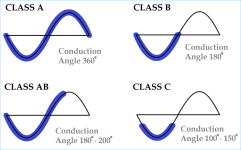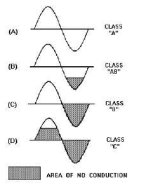merhaba, ax 6500 ve ax6300 olmak üzere iki adet 4 ve 2 kanallı modelim var, class aa scam mı yoksa gerçekten class a mı? yoksa sınıfta biraz watt olarak mı çalışıyor siz değerli forum üyelerinden bilgilerini rica ediyorum.








Hello, I have two 4 and 2 -channel models, Ax 6500 and Ax6300, Class AA SCAM or really Class A? Or I would like to ask you for the information from our esteemed forum members.
English please.
dave

diyAudio moderation team
sorry the translator made a mistakeEnglish please.
dave
diyAudio moderation team
It doesn't say that the output stage is the Class A circuit. Some amps have a class A preamp stage. Some simply use pull-up resistors to the op-amp supply voltage (connected to the op-amp output) to force the op-amp into passing current at all times which they consider to be class A operation.
In some amps, they can use tracking power supplies to make it run efficiently at full class A but I don't see that there.
The single 2w emitter resistor on each output transistors doesn't seem like a pure class A output section.
If it has more than about ±15v of rail voltage, it's not likely to be a pure class A output stage with that small heatsink.
As was stated above, it may be class A (output stage) up to a watt or two but that's more likely a high-biased class AB.
In some amps, they can use tracking power supplies to make it run efficiently at full class A but I don't see that there.
The single 2w emitter resistor on each output transistors doesn't seem like a pure class A output section.
If it has more than about ±15v of rail voltage, it's not likely to be a pure class A output stage with that small heatsink.
As was stated above, it may be class A (output stage) up to a watt or two but that's more likely a high-biased class AB.
So how are these amps efficient in use with the processor in the SQ system, how do you rate the sound color?
As i understand that it is possible to reduce the power consumption of a "Class A" amp with sliding something (bias? rails?).
It suggests to me complexity that a basic Class A amplifier does not have to concern itself with. So less room for chaos.
There should be a lot of discussion on the subject here already.
dave
It suggests to me complexity that a basic Class A amplifier does not have to concern itself with. So less room for chaos.
There should be a lot of discussion on the subject here already.
dave
hello, I have two 4 and 2 channel models, ax 6500 and ax6300, is it class a scam or is it really class a? Or does it work as a bias watt in the classroom, I ask you valuable forum members for their information.merhaba, ax 6500 ve ax6300 olmak üzere iki adet 4 ve 2 kanallı modelim var, class aa scam mı yoksa gerçekten class a mı? yoksa sınıfta biraz watt olarak mı çalışıyor siz değerli forum üyelerinden bilgilerini rica ediyorum.
View attachment 1196144View attachment 1196145View attachment 1196146View attachment 1196147View attachment 1196148View attachment 1196149View attachment 1196150View attachment 1196151
Looks like it's an amp for use in a car. Max power spec probably in bridge mode and 2ohm speakers.
The manual can be found on the web.
The manual can be found on the web.
https://en.wikipedia.org/wiki/Power_amplifier_classesHow do YOU define class A?
Why do you want class A?
Attachments
I wanted to know how HE defined class A. Class AB is class A up to a certain level. Full, normal, class A dissipates a LOT of heat if the rail voltage is fixed.
There is no real advantage to class A. Douglas Self got VERY good, very low distortion results from class B.
Some people hear garbage on the internet and take it for granted/gospel. That's why I wanted to know his definition/reasoning behind the question about class A.
There is no real advantage to class A. Douglas Self got VERY good, very low distortion results from class B.
Some people hear garbage on the internet and take it for granted/gospel. That's why I wanted to know his definition/reasoning behind the question about class A.
Very pertinent questions. The answer to the first would determine if sliding bias can or cannot qualify as class A.How do YOU define class A?
Why do you want class A?
The second is easier to answer. In most implementations it has a specific, hard to duplicate sonic flavour. It also allows to design very low distortion amplifiers without resorting to loop NFB.
To me there is only real classA. Outputs never switch.
If it is 100 watts classAB, but it only makes 0.5 watt without switching, its bs, not classA.
If it is 100 watts classAB, but it only makes 0.5 watt without switching, its bs, not classA.
I agree and thats why a high-biased class AB is class A only at very low power. Definitions vary from person to person. For him to get a definitive answer, he will need to be more specific and provide more information.
I use this oneHow do YOU define class A?
The type of “Class” or classification that an amplifier is given really depends upon the conduction angle, the portion of the 360o of the input waveform cycle, in which the transistor is conducting. In the Class A amplifier the conduction angle is a full 360o or 100% of the input signal while in other amplifier classes the transistor conducts during a lesser conduction angle.
It doesn't really matter how this is achieved.
Those that use them tend to look at the power needed at listening distances. For instance loudspeaker
spl 87db. 10w amp the 5m spl is ~85db, 15w would push it up to ~90db 15w per channel stereo was high power in the "olden days". 😉 More wide spread use of "hifi" and transistors pushed that up pretty quickly starting in say the mid 60's.
- Home
- General Interest
- Car Audio
- pure Class A real?

